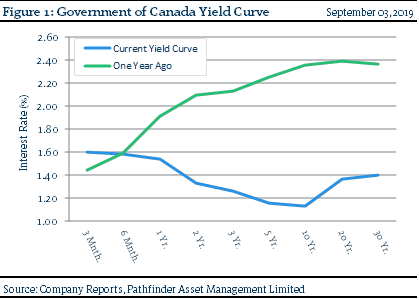Recap & Outlook: Fixed Income Portfolio adjustment
We last wrote about the inverted yield curve in Canada and the US. This is a relatively rare event, so we followed up on our regular Investment Outlook with a letter to you that explained our views in a little more detail. Please feel free to reach out directly to anyone on the Investment Team if you have any further questions about this. We told you that the curve inversion, in and of itself, did not change our investment view. However, we made some trades that we will write about today.
Our clients know that we are not great proponents of fixed income in the current investment environment. When I first started in the investment industry, I could buy good quality bonds that paid high single and even double digit returns (if you are willing to take on a little more risk). Those days are long gone and given the state of central bank influences, I am not sure when they will be back. Thus, at Pathfinder, we use fixed income more as a store of value, rather than a place where excess return can be generated. By definition, we do not trade in this portfolio very often; however, the inverted yield curve gave us an opportunity to crystalize some profits for our clients, so we took that opportunity last week.
- Figure 1 presents the current Canadian yield curve as of today (blue line) vs what it was a year ago (green line). As you can see, the blue line is tilted down (i.e. the inversion) while the green is tilted up. It is the change in this line that gave us the trading opportunity.

- As we noted in our letter to you, there is an inverse relationship between bonds yields and bond prices, so when the green line dropped to the level of the blue line, the longer-term bonds that we owned in the portfolio increased in price. So we sold them.
- Another item to note about the blue line is that the yield to maturity on the longer dated bonds is lower than the short-term treasury bills, so when we sold the bonds we were able to lock in a good profit and then rotate the resulting cash into a treasury bill that offers a higher yield. For your information, we sold the following bonds: Bank of Nova Scotia 3.1% 2028, Bell Canada 2.9% 2026, Brookfield Asset Management Inc 3.8% 2027, Canadian National Railway 2.8% 2025, Fortis Inc 2.9% 2023, and replaced them with a 6-month Canadian T-bill.
“This means that” we will hold the bills and roll them into the next term when they mature for a period of time until the yield curve becomes more normally shaped. When that happens, we will be able to buy back the bonds that we sold (or similar type bonds) at a lower price.
National Instrument 31-103 requires registered firms to disclose information that a reasonable investor would expect to know, including any material conflicts with the firm or its representatives. Doug Johnson and/or Pathfinder Asset Management Limited are an insider of companies periodically mentioned in this report. Please visit www.paml.ca for full disclosures.
*All returns are time weighted and net of investment management fees. Returns from the Pathfinder Partners’ Fund and Partners’ Real Return Plus Fund are presented based on the masters series of each fund. The Pathfinder Core: Equity Portfolio and The Pathfinder Core: High Income Portfolio are live accounts. These are actual accounts owned by the Pathfinder Chairman (Equity) and client (High Income) which contain no legacy positions, cash flows or other Pathfinder investment mandates or products. Monthly inception dates for each fund and portfolio are as follows: Pathfinder North American: Equity Portfolio (January 2011), Pathfinder North American: High Income Portfolio (October 2012) Pathfinder Partners’ Fund (April 2011), Pathfinder Real Return Plus Fund (April, 2013), Pathfinder International Fund (November 2014) and Pathfinder Resource Fund (May 2018).
Pathfinder Asset Management Limited (PAML) and its affiliates may collectively beneficially own in excess of 10% of one or more classes of the issued and outstanding equity securities mentioned in this newsletter. This publication is intended only to convey information. It is not to be construed as an investment guide or as an offer or solicitation of an offer to buy or sell any of the securities mentioned in it. The author has taken all usual and reasonable precautions to determine that the information contained in this publication has been obtained from sources believed to be reliable and that the procedures used to summarize and analyze such information are based on approved practices and principles in the investment industry. However, the market forces underlying investment value are subject to sudden and dramatic changes and data availability varies from one moment to the next. Consequently, neither the author nor PAML can make any warranty as to the accuracy or completeness of information, analysis or views contained in this publication or their usefulness or suitability in any particular circumstance. You should not undertake any investment or portfolio assessment or other transaction on the basis of this publication, but should first consult your portfolio manager, who can assess all relevant particulars of any proposed investment or transaction. PAML and the author accept no liability of any kind whatsoever or any damages or losses incurred by you as a result of reliance upon or use of this publication.